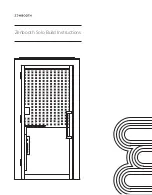
10
307363
Operation
Determining the Proper Fluid Temperature
CAUTION
Use the lowest temperature setting needed, for
maximum heater life. Operating the heater at its
highest setting – over 82
_
C (180
_
F) – for long peri-
ods of time decreases the heater life.
Higher than necessary temperatures also causes the
fluid to dry out, resulting in a poor finish and clogging
the heater.
The chart in Fig. 6 is used on determining the Under–
Boil
r
temperature. It also shows the effect of tempera-
ture on reducing viscosity. Notice that most of the
viscosity reduction occurs by 55
_
C (130
_
F).
Under–Boil is the Graco method of hot, airless spray-
ing in which the fluid is heated to a temperature just
under the boiling point of its most volatile solvent.
To find the Under–Boil temperature of your fluid:
1.
Pour a small sample into a heat–proof container.
2.
Measure and record the temperature and viscosity
of the fluid. Use a No. 2 Zahn cup.
3.
Heat water in a large container to 93
_
C (200
_
F).
Place the sample in the water.
4.
At every 10
_
temperature rise, measure and
record the viscosity and temperature. Do this until
solvents start boiling off and the viscosity starts to
level off – usually 71
_
to 77
_
C (160
_
to 170
_
F).
5.
Subtract the lowest viscosity reading from the
highest one. Multiply that result by 0.90. Subtract
the new result from the highest viscosity reading.
Find this number on your temperature and viscos-
ity records. This is the temperature to use in your
Under-Boil system.
Fig. 6
EFFECT OF TEMPERATURE ON REDUCING VISCOSITY
UNDER–BOIL METHOD
0
10
20
30
40
50
60
70
80
90
100
60
80
100
120
140
160
180
TEMPERATURE (
_
F)
HEAVY LACQUER
MEDIUM LACQUER
ENAMEL
VISCOSITY
TIME IN
SECONDS
with No. 2
ZAHN CUP
Fig. 7
Effect of Temperature in Reducing
Two Fluids to a Sprayable Viscosity
60
80
100
120
20
30
40
50
60
140
n
U
2
nU
1
TYPICAL HIGH–SOLID PAINT
TYPICAL ENAMEL PAINT
TYPICAL
SPRAY
VISCOSITIES
APPARENT
VISCOSITY
with NO. 2
ZAHN CUP
TEMPERATURE (
_
F)
The chart in Fig. 7 shows the effect of tempera-
ture in reducing two fluids to a sprayable vis-
cosity – in the range of 20 to 34 seconds using
a No. 2 Zahn cup.
Notice that temperature has more of an effect
on high solid fluids than on thin enamels. That
is, for the same 10
_
temperature rise, more
viscosity reduction occurs in the high solid fluid
than the enamel. This shows that high solid
fluids are “temperature sensitive,” which needs
to be taken into consideration when planning
your system.
Also note that once the fluid is reduced to
about 34 on the chart, viscosity reduction starts
to level off. Therefore, high temperatures will
not significantly improve sprayability, but will
use more energy.
EFFECT OF TEMPERATURE ON VISCOSITY
Summary of Contents for 226816
Page 13: ...307363 13 Notes...
Page 17: ...307363 17 Notes...
Page 22: ...22 307363 Dimensions Mounting Hole Layout 4 in 102 mm 6 5 in 165 mm 0 41 in 10 4 mm dia...
Page 23: ...307363 23 Notes...










































